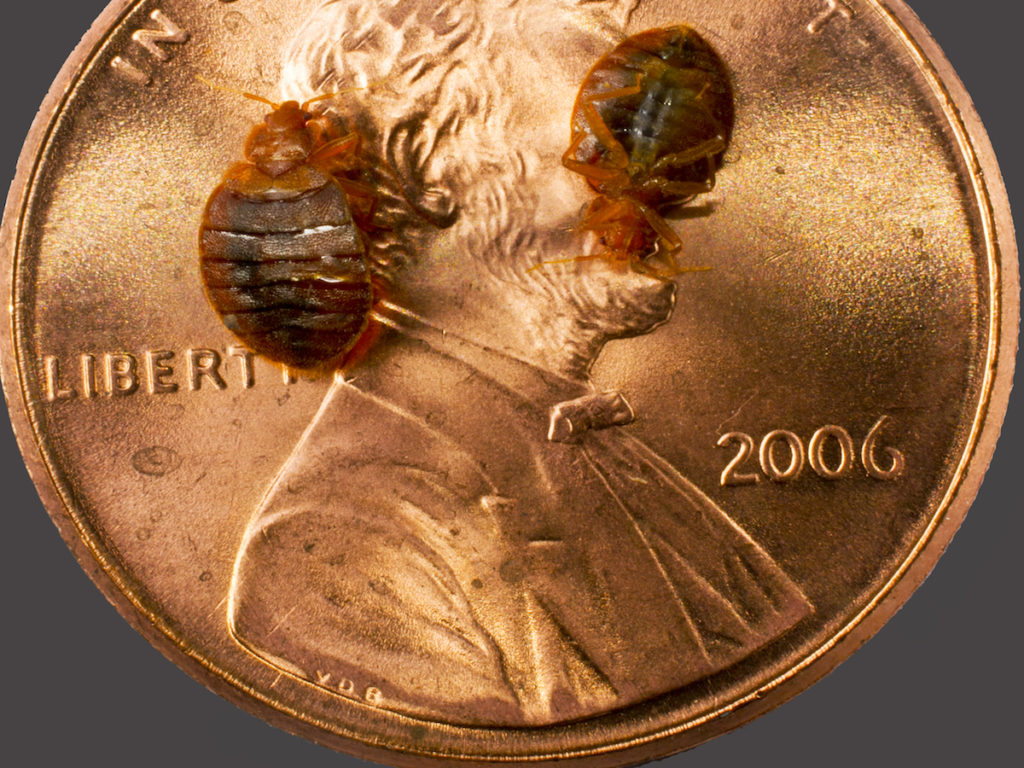Bed bugs likely get their name from their habit of feeding on humans while they sleep in their beds. They are found in virtually every place people tend to gather, including residences, hotels, schools, offices, retail stores and even public transportation.
The two species of bed bugs (Insecta: Hemiptera: Cimicidae) usually implicated in human infestations are Cimex lectularius and C. Hemipterus. Although rare, humans may become incidental hosts of Cimex species of bats and birds.

PEST SPECS
Color:
Unfed adults are mahogany.
Engorged bed bugs are red-brown.
Nymphs are nearly colorless.
Legs:
6
Antennae:
Yes
Shape:
Unfed adults are flat, broad oval.
Engorged bed bugs are swollen and elongated.
Size:
Adults are 1/4 inches long.
Nymphs range from 1.3mm to 4-5mm long.
Region:
Found throughout U.S.
Life Cycle
After mating, females lay white, oval eggs (1/16″ long) into cracks and crevices. An individual bed bug can lay 200 to 250 eggs in her lifetime. The eggs hatch in 6 to 10 days and the newly emerged nymphs seek a blood meal. Immature nymphs molt five times (they shed their outer exoskeleton) before reaching adulthood. There may be three or more generations per year. All ages are found in a reproducing population. Under normal circumstances adult bed bugs will live for about 2 to 4 months. Bed bugs need to feed at least once before each molt, although they could feed as often as once a day. Young nymphs can survive without a blood meal for days up to several months. Older nymphs and adults can survive longer without a blood meal up to a year under favorable conditions.
Habits
Bed bugs like to travel and are good hitchhikers. They will hide in suitcases, boxes and shoes to be near a food supply. They are elusive, nocturnal creatures. They can hide behind baseboards and in cracks, crevices, and folded areas of beds, bedding and adjacent furniture, especially mattresses and box springs. Bed bugs can also hide in electrical switchplates, picture frames, wallpaper and nearly anywhere inside a home, car, bus, or other shelter. Bed bugs usually come out at night for a blood meal. However, they are opportunistic insects and can take a blood meal during the day, especially in heavily-infested areas. Bed bugs usually require 5-10 minutes to engorge with blood. After feeding, they move to secluded places and hide for 5-10 days. During this time in the bed bug life cycle, they do not feed but instead digest their meal, mate, and lay eggs.
Habitat
So where do bed bugs live? Bed Bugs like to hide in small cracks and crevices close to a human environment. They can be found behind baseboards, wallpaper, upholstery, and in furniture crevices. Bed bugs are also known to survive in temporary or alternative habitats, such as backpacks and under the seats in cars, busses, and trains.
Threats
Although bed bugs can dine on any warm-blooded animal, they primarily dine on humans. Bed bugs aren’t known to spread disease, they can cause other public health and economic issues. But, I mean, you do have government sites stating that “Bed bugs are suspected of transmitting infectious agents, but no report has yet demonstrated that they are infectious disease vectors” like the U.S. National Library of Medicine.
Sources:
https://www.cdc.gov/parasites/bedbugs/biology.html
https://www.pestworld.org/pest-guide/bed-bugs/bed-bugs/
https://www.ncbi.nlm.nih.gov/pmc/articles/PMC3060893/
